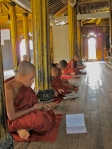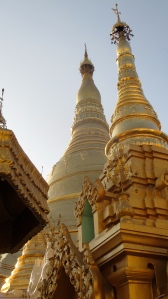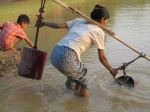Travel, Fear, and Misperception: Burma as Destination and Metaphor
Posted on April 13, 2011 at 11:29 pm
I first traveled to Burma in 1996, co-leading an educational tour with a group of eighteen students from New College of California. Burma had just opened to the west after thirty years and Aung San Suu Kyi, the democratically elected president, who had been under house arrest by the military regime since her election in 1988, had just been released.
There were almost no tourists, partly due to Suu Kyi’s call for a travel ban as well as a generalized fear of the military. Decades of isolation had left the country shabby, full of broken roads and drab hotels. Yet at the same time, because of this isolation, Burmese traditions were intact. Rows of barefoot monks walked the streets of  Yangon, carrying their bowls from house to house, collecting food for the day, before heading back to their monasteries for meditation and instruction. Men and women were dressed in traditional, non-western clothing, and there was not a McDonalds or Kentucky Fried Chicken in sight. It was a fascinating, powerful travel experience.
Yangon, carrying their bowls from house to house, collecting food for the day, before heading back to their monasteries for meditation and instruction. Men and women were dressed in traditional, non-western clothing, and there was not a McDonalds or Kentucky Fried Chicken in sight. It was a fascinating, powerful travel experience.
I have just returned from my fifth trip, this time leading a group of six. Close to our departure, I was bombarded with questions of concern by some of the group members. “My aunts, friends, daughter just returned from travel to Burma and said that cameras and cell phones were confiscated at the airport and that there were armed military personnel everywhere. Sounds very dangerous. Can you check into this?” I did. Calls to both the Embassy of Myanmar in Washington, D.C. and my local agents in Yangon, drew puzzled responses. I assured everyone that I would not bring a group to a place where I felt they would be endangered, and that in fact, I believed Burma was a safer travel destination than the upper west side of Manhattan where several concerned members of the group resided.
Yet the “fear factor “ remained high right up until arrival at the airport in Yangon. A steamy, verdant colonial outpost, Yangon is full of old apartment buildings, grand colonial homes in disrepair, and streets crowded with bicycles, motorbikes, and bustling markets. We watched it all through the mini-bus windows and then, at our lovely hotel, the Governor’s Residence, we got to relax by the pool, drink Myanmar Beer, and recover from the jet lag and exhaustion of our 24 hour trips.
We began the next morning at the Great Reclining Buddha of Chaukhtatgyi, a  beautiful, 230 foot long structure, and ended at Shwedegon Pagoda. One of the wonders of the world, Shwedegon’s gold plated stupa rises 322 feet, and is topped by a 120 karat diamond that reflects the days last sunlight. I walked barefoot on the cool marble tiles, amazed at the scene. People pouring water on the heads of small Buddha statues, lighting candles, and chanting prayers, some of which were broadcast loudly through a crude speaker system. And as gongs chimed and incense burned, I was swept up in a deep sensorial cloud, my head spinning with the sudden realization of how very far away from home I was.
beautiful, 230 foot long structure, and ended at Shwedegon Pagoda. One of the wonders of the world, Shwedegon’s gold plated stupa rises 322 feet, and is topped by a 120 karat diamond that reflects the days last sunlight. I walked barefoot on the cool marble tiles, amazed at the scene. People pouring water on the heads of small Buddha statues, lighting candles, and chanting prayers, some of which were broadcast loudly through a crude speaker system. And as gongs chimed and incense burned, I was swept up in a deep sensorial cloud, my head spinning with the sudden realization of how very far away from home I was.
But I was quickly brought down to earth when I heard the news that one of our group members, Howard, had accidentally walked away from his camera bag filled with equipment and money and that it was now missing. Soon afterwards he found us  and reported what had happened. When Howard realized his bag was gone, he and his partner found the Shwedegon administrative office. After they walked in, and reported the lost camera bag, the two were met with excited applause. His bag had been found and an announcement had already been made (in Burmese) over the loudspeaker system. The officials now guarding the lost goods insisted that Howard make sure the bags contents were intact. After confirmation, the officials requested photos with Howard and his recovered property. A happy ending to our first day in Burma and I could not help but wonder what might have happened to that camera bag were it found in the middle of Grand Central Station in New York City.
and reported what had happened. When Howard realized his bag was gone, he and his partner found the Shwedegon administrative office. After they walked in, and reported the lost camera bag, the two were met with excited applause. His bag had been found and an announcement had already been made (in Burmese) over the loudspeaker system. The officials now guarding the lost goods insisted that Howard make sure the bags contents were intact. After confirmation, the officials requested photos with Howard and his recovered property. A happy ending to our first day in Burma and I could not help but wonder what might have happened to that camera bag were it found in the middle of Grand Central Station in New York City.
Our trip continued onto Mandalay, Burma’s second largest city. A scruffier version of Yangon, Mandalay was the old capital and still is a major craft center. We visited the ancient wooden monastery of Kyaung Shwenandaw, the enormous Mahamuni  Buddha, its body fat with decades of pressed gold leaf, and the neighborhoods devoted to woodworking, marble and bronze sculpture, and gold leaf production. On the morning of our departure, near the old palace moat, I saw people doing tai chi, monks on public elliptical machines, and jogging teenage girls and boys. We eyed each other with curious smiles.
Buddha, its body fat with decades of pressed gold leaf, and the neighborhoods devoted to woodworking, marble and bronze sculpture, and gold leaf production. On the morning of our departure, near the old palace moat, I saw people doing tai chi, monks on public elliptical machines, and jogging teenage girls and boys. We eyed each other with curious smiles.
That afternoon, I spent hours on the deck of an elegant old Burmese river cruiser, gazing upon the great Irrawaddy. The shores were lined with goatherds, fishermen, and villages of bamboo, and the river itself teemed with floating cargo, a great industrial highway through the heart of the country. Huge rafts carrying teak downstream and vessels full of onions and tomatoes sweetened the desert air. And at days end, a blood red sunset over the distant Shan hills.
When we came ashore in Pagan, we were assaulted by a barrage of men, women, and children, selling trinkets of every sort. Plastic rubies, “ancient’ Buddha heads made the week before, and bootlegged copies of George Orwell’s “Burmese Days”. “Hey Mister. Where you from? Oh America! America very good”. And when I finally got through the fray, I looked up to see dozens of glittering monuments lining the river and dotting the landscape beyond.
Different from abandoned ruins sites, Pagans temples are still active places of worship and meditation. Through the ruins, we rode bicycles along dirt roads to villages deep in the countryside, some without electricity or running water and watched girls and boys carrying buckets of water, over their shoulders, from a small river outcropping to their bamboo and jungle leaf homes. The homes were simple–fire pits for cooking, sleeping mats, some pots and pans. Outside, drying produce, a weaving loom. The people were
Through the ruins, we rode bicycles along dirt roads to villages deep in the countryside, some without electricity or running water and watched girls and boys carrying buckets of water, over their shoulders, from a small river outcropping to their bamboo and jungle leaf homes. The homes were simple–fire pits for cooking, sleeping mats, some pots and pans. Outside, drying produce, a weaving loom. The people were  poor, but I didn’t feel poverty. Children followed us down dusty paths, laughing as we gave them candy and played singing games. I saw no hunger, desperation, or begging, but rather, simple lives without grand aspirations and illusions, people born into villages from which they would not likely wander off. I saw an old man smoking a cigar beside his family hut who knew that he would die in that hut, cared for until the end by his family.
poor, but I didn’t feel poverty. Children followed us down dusty paths, laughing as we gave them candy and played singing games. I saw no hunger, desperation, or begging, but rather, simple lives without grand aspirations and illusions, people born into villages from which they would not likely wander off. I saw an old man smoking a cigar beside his family hut who knew that he would die in that hut, cared for until the end by his family.
It was the same at our final destination, Inle Lake–people living on the water as they have for centuries. “foot rowers”, paddling with their legs as they cast their pyramidal nets, bringing their catch onto narrow hand carved boats; farmers waiving to us from floating fields while their water buffalo trudged through the muddy shallows, pulling bundles of lake weed to fertilize the already rich soil.
Because Burma has been isolated for so many decades, it has been removed from our cultural imaginations. Millions go to Thailand, and Cambodia, and Vietnam, all neighbors with common cultures, histories, geographies, and religions. Yet when telling someone that you are going to Burma, the response is often a stare and a “Why there?”
Upon conclusion of the trip, the group agreed that Burma was “the opposite of dangerous” and that, while the brutality of the military regime is quite real, the fears and misperceptions that people brought to Burma were unfounded. And it left me wondering about the nature of perception and how we carry so much fear within us and how that prevents us from truly “seeing” the world.  And not just the world of foreign travel but the
And not just the world of foreign travel but the  world in which we live every day. I realized that our trip to Burma was a metaphor for how we live our lives, how we project our internalized fears onto everyone and everything around us so that after awhile we are living in bubbles, the world beyond a mirror of our fearful selves. Our hides thicken, until we feel nothing but our own internal gyrations.
world in which we live every day. I realized that our trip to Burma was a metaphor for how we live our lives, how we project our internalized fears onto everyone and everything around us so that after awhile we are living in bubbles, the world beyond a mirror of our fearful selves. Our hides thicken, until we feel nothing but our own internal gyrations.
To travel is to be challenged by unfamiliar surroundings and unexpected beauty, to push ourselves into realms that reveal not only new and different places, but new ways of being. To travel is not only to see the world, but to see ourselves.
3 thoughts on “Travel, Fear, and Misperception: Burma as Destination and Metaphor”
Comments are closed.
Ahhh, Myanmar is anything but dangerous. Great people. I recognize that lady (goatherder) in the next to last shot. Bagan.
Good post,
John
Thank you for sharing your insights and experiences, and the beautiful photographs, Ricky!
I would love to hear about any music you heard, and the cuisine there!
Thank you Ricky. Wonderful reflections from your travel on our modern fears and insecurities. Along with your beautiful photos, your writings transported to me so that I felt I had touched a bit of Myanmar.
Peggy